Liana electronic intelligence satellite (original) (raw)
Lotos-S spacecraft for the Liana system
As one of the key space-based assets of the Russian military at the beginning of the 21st century, the Lotos-S spacecraft was designed for orbital electronic intelligence, ELINT, also known in Russian as KREN. Radio signals intercepted by the satellite would help to locate, characterize and target various military vehicles and installations. Although Lotos-S satellites would not be directly identified as such during launches and would enter orbit under anonymous Kosmos names, a number of official Russian publications and mass media statements did reveal general information about the project.
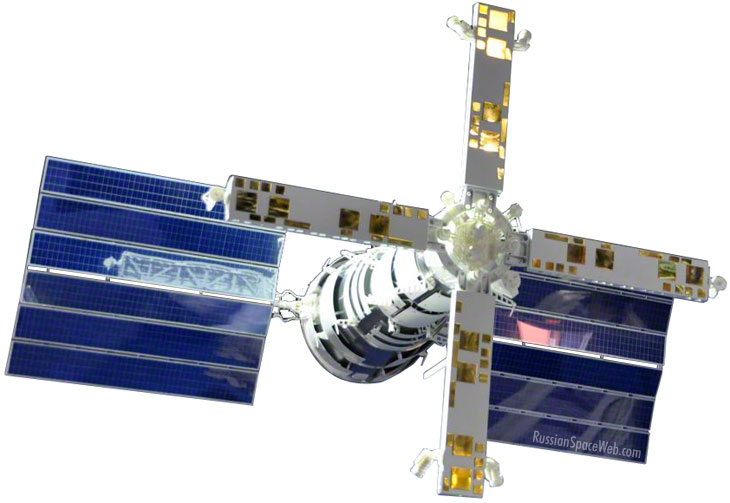
Scale model of the Lotos-M spacecraft.
History of the Liana project
During the Soviet period, four generations of the Tselina spacecraft developed by KB Yuzhnoe in Dnepropetrovsk provided the Soviet military with electronic intelligence. Work on the third-generation of the spacecraft -- Tselina-3 -- started in 1985 and its preliminary design was completed in 1989. However with the disintegration of the USSR in 1991, KB Yuzhnoe ended up in the newly independent Ukraine. To secure its strategic assets, the Russian political and military leadership sought to transfer all significant military projects out of the independent republics into Russia.
During 1993, the TsNIRTI radio technology institute, also known as the Berg institute after its founder, completed a preliminary engineering proposal for the Liana system, that was supposed to succeed the Tselina network. The document became the base for a government decree authorizing the full-scale development of the Liana system. Given the Berg institute's previous experience in radio-electronic warfare, the government awarded the organization the status of chief developer of the overall network as well as its associated ground-based hardware and satellites' onboard payloads. Within the organization, Aleksandr Lebed, the head of Department NTO-32, was appointed chief-designer of the Liana network. Yuri Kharitonov, the head of Department 32.1, led the development of the Bars payload.
During 1994, the organization developed a preliminary design of the system, aiming to use the Zenit launcher, ironically also developed and built in Dnepropetrovsk, Ukraine. Since the Russian government also wanted the Liana network to succeed US-PM naval ELINT satellites, various conflicting requirements led developers to propose two variations of future satellites -- Lotos and Pion. Pion-NKS (14F139) carrying a radar antenna was expected to replace both the US-A and US-PU satellites, providing electronic intelligence and target guidance for the Russian navy. The overall system or complex, including the Pion spacecraft and its ground complex had apparent designation 14K160.
Still, developers hoped to minimize the range of hardware needed for the two sub-systems and give both versions of the satellites the capability to back up each other, while at the same time, Lotos and Pion could still pursue their specific tasks. Such an approach, which had failed during the development of previous generations of ELINT systems in the Soviet period, promised to cut cost and shorten development time.
During 1996-1997, with the semi-official slogan "not a single ruble to Ukraine" taking root, developers were asked to "re-tailor" the project from the Zenit to the Soyuz-2-1b rocket. Along with the launch vehicle, the project's base moved from Baikonur to Plesetsk.
In 2002, the project was shaken again by the decision to squeeze it into the existing spacecraft bus originally developed by TsSKB Progress of Samara for the Kobalt and Resurs DK satellites. This move was apparently preceded by an ill-fated effort by KB Arsenal in St Petersburg to develop a custom-built satellite platform for Liana. One of the stumbling blocks was a system of radiators and batteries which failed to maintain required thermal conditions onboard the satellite and ultimately led to the demise of the project. Although TsSKB Progress in Samara got the task of building the spacecraft bus, its final assembly still remained at KB Arsenal. The same arrangement apparently existed with previous military satellite programs.
As a result of these critical changes, the future spacecraft had to slim down by some 30 percent, which apparently led to limitations on the capabilities of the system, while at the same time pushing development behind schedule and ballooning its price. Main panels of Lotos satellites carrying antennas of the Bars sensors had to be significantly reduced in size, compared to a previous-generation Brig payload onboard the Tselina-D spacecraft and Korvet sensors onboard Tselina-2.
In the end, the payload mass of the Lotos and Pion spacecraft was reduced by a factor of 2.5-2.8 times while the satellites themselves became 1.48-1.6 times lighter. While costing more, mass reduction prompted the introduction of some progressive technologies on both spacecraft, including the use of digital signal processing in the Bars payload. In turn, it enabled pinpointing sources of electronic signals onboard the satellite itself, thus significantly improving the capabilities of the Liana network.
In 2005, at the request of future users of the system, developers prepared a new preliminary study aiming to extend the projected lifespan of the Lotos satellite to five years and that of Pion to four years. A year later, proposed upgrades were approved as a basis for further development of the spacecraft. (366)
Final architecture of the system
During more than 15 years in development, the Liana project has suffered from all the common problems of the Russian defense industry - low funding, brain drain, mismanagement and deteriorating infrastructure. According to unofficial reports various technical and financial problems led to splitting the development of the Lotos satellite into two phases. A "streamlined" version of the spacecraft, known as Lotos-S or 14F138, would fly first on Soyuz-U, followed by a full-scale spacecraft designated 14F145 or Lotos-S1 to be launched by Soyuz-2-1b in 2012 at the earliest. The integrated complex of the Lotos-S1 spacecraft and the Soyuz-2 launch vehicle has a designation 14K159.
In case of three simultaneously operating spacecraft, they would be spread out so that the longitude of ascending nodes of their orbits (a point where ground track of the orbit crosses the Equator from Southern to Northern Hemisphere) would be 120 degrees apart.
As a Russian-built equivalent of the Tselina satellite, Lotos-S ended up to be much more expensive than its "foreign" predecessor, while reportedly offering little or no improvement in technical capabilities compared to Tselina. In the meantime, Lotos development kept dragging behind schedule and operational Tselina satellites were going out of business, leaving the Russian military without crucial space-based means of electronic intelligence. In desperation, the Russian military reportedly even mulled a possibility of purchasing an equivalent system abroad.
A scandal on the launch pad
The first Lotos-S had finally reached the launch pad at the end of July 2009, however new technical problems surfaced again shortly before its scheduled July 28 liftoff. This time, launch personnel at Plesetsk either did not have proper equipment or could not access one of the failed components, thus requiring the return of the entire spacecraft to the manufacturer's plant in St Petersburg.
Moreover, it was rumored that the service module of the spacecraft had to be disconnected and returned to TsSKB Progress in Samara, at least in part due to oil contamination allegedly caused by the air-conditioning system at the Arsenal's poorly maintained assembly plant. (During tough economic times, the facility was rented out as a container storage frequented by heavy trucks, which led to severe contamination of the site.)
The latest incident triggered a major scandal within the industry. Roskosmos leadership had had enough and dismissed the head of the project at KB Arsenal and gave TsSKB Progress general command of the ongoing work. Even a full transfer of the Liana spacecraft integration from St. Petersburg to Samara was rumored in unofficial Internet postings.
In the meantime, the satellite's propulsion module loaded with corrosive propellant faced tight certification deadlines before it could be launched without major refurbishment. All vacations and time off for employees involved in the project was reportedly prohibited until repairs on Lotos-S were completed.
Lotos-S No. 1 launch in 2009
Russia has launched a classified payload, apparently introducing a new family of electronic intelligence satellites. A Soyuz-U rocket lifted off from Plesetsk Cosmodrome on Nov. 20, 2009, at 13:44 Moscow Time carrying a military satellite designated Kosmos-2455, official Russian sources said. According to the Space Forces' spokesman, the satellite entered its planned orbit at 13:52 Moscow Time and a minute later established contact with ground control.
Western radar detected the satellite in a 200 by 905-kilometer orbit with an inclination of 67.2 degrees toward the Equator. The upper stage, which delivered the satellite was seen in a similar orbit. Just two days after the launch, the spacecraft conducted a strange short maneuver, which raised its perigee by five kilometers, in a possible test of its propulsion system. It was followed by a "normal" maneuver, which circularized the orbit at an altitude of 890 - 905 kilometers, where the spacecraft was likely to operate. Nevertheless, around four days after the launch, unofficial reports said that at least one of the panels, carrying critical intelligence antennas had not deployed. The problem was apparently caused by the failure of a electric drive or its heater, both built by KB Arsenal. However the issue was reportedly resolved sometimes before November 29. Still, the satellite did continue conducting modest adjustments of its orbit in the first week of December 2009.
On March 23, 2010, Aleksandr Kirilin, the head of TsSKB Progress in Samara, in his address to the meeting of the company's administration said that testing of a spacecraft "launched on Nov. 20, 2009," was continuing and the company's specialists along with sub-contractors "would have to resolve existing issues, in order to provide the quality work of the vehicle."
Nuklon experiment
Continuing a tradition of dual-purpose missions, KB Arsenal, the primary integrator of the Lotos-S spacecraft, planned to use it as a platform for the Nuklon experiment. According to the company, the instrument was designed to detect high-energy cosmic rays and it was expected to fly during a period from 2008 to 2010. An illustration, which accompanied the publication, revealed that the Nuklon payload would hitchhike a ride to space onboard the Lotos satellite. (See image) It would be deployed in orbit in a fashion similar to that of the Arina scientific package, which rode to orbit onboard the Resurs-DK spacecraft. Both satellites share the service module carrying the instrument's deployment mechanism. It was unclear whether the Nuklon would fly with the very first Lotos satellite or on one of the subsequent missions.
Mission status in 2012
Speaking at the expanded meeting of the company's management on November 16, 2012, the head of TsSKB Progress Aleksandr Kirilin said that a spacecraft equipped with the company's service module had been working successfully following its launch in 2009. He noted that there had been no issues with the module and the spacecraft had remained operational. However, a poster on the web forum of the Novosti Kosmonavtiki magazine commented that the satellite had lost its capability to perform its primary operational function in December 2011.
Lotos-S No. 2
Despite original plans to launch a fully operational version of the Lotos-S payload in 2012, problems with the original satellite probably contributed to its delay. The delays of critical components were also reported at MZ Arsenal, the prime integrator of the satellite, leaving around a year for the final assembly.
In April 2014, KB Arsenal's officials disclosed that the "second-phase" Lotos-S spacecraft had been undergoing final electric and radio testing and it would be launched before the end of the year. The company also hinted that this type of the satellite was entering a serial production with orders extending at least until 2018. KB Arsenal design bureau would oversee the serial production of Lotos-S at the company's adjacent mechanical plant MZ Arsenal in St. Petersburg. Also in 2014, the decision was made to transfer the manufacturing of the complex Support Module, Obespechivayushiy Modul, OM, from TsSKB Progress to MZ Arsenal.
KB Arsenal officials also claimed that the Lotos No. 1 satellite had continued functioning and would work in tandem with the second satellite, thus providing higher quality data.
In the meantime, Lotos-S No. 2 was delivered to Plesetsk on November 17, 2014, for a month-long pre-launch processing. It included loading cooling fluid into the satellite's thermal control system, fueling its propulsion system and the assembly of the payload section for the integration with the launch vehicle. The preparation reportedly went without a hitch.
In December 2014, the liftoff of Lotos-S was apparently postponed by a few days due to a schedule conflict with a maiden launch of the Angara-5 rocket on December 23. The 14F145 spacecraft with the Lotos-S payload was scheduled for launch on the Soyuz-2-1b rocket on December 25.
At the beginning of December 2014, the authorities in the Yamal Region in the north of Russia warned local residents to avoid an area with coordinates of 67 degrees 9 minutes North latitude and 69 degrees 56 minutes East longitude north of the village of Yar Salye during a period from December 25 to December 27. The location of the drop zone confirmed that the launch will likely target a similar orbit to the one in the original Lotos-S mission -- 67.2 degrees toward the Equator.
The launch vehicle was rolled out to a snow-covered Pad 4 at Site 43 in Plesetsk on December 22, around two days before a scheduled liftoff. However, around a day and a half before launch, a technical problem was discovered in the rocket, which could potentially require to return it to the assembly building. Specialists worked throughout the remainder of the day and during the night to resolve the issue. On December 24, at 11:00, the State Commission overseeing the launch held an emergency meeting and its chairman gave green light to further operations.
During the night from December 24 to December 25, at around 02:30, members of the State Commission met again at the launch facility and gave a final go ahead to irreversible operations with the rocket and the spacecraft.
The liftoff of a Soyuz-2-1b rocket took place as scheduled on Dec. 25, 2014, at 06:01 Moscow Time. Around 10 minutes after the liftoff, the launch vehicle successfully delivered the satellite into orbit.
After reaching the orbit, the spacecraft received an official designation Kosmos-2503.
Lotos-S No. 2 in orbit
Apparently, in another clumsy disinformation attempt, at least one official report, which apparently originated on the web site of the Ministry of Defense, identified the Lotos-S payload as a communications satellite. This unbelievable claim was then reproduced by the official RIA Novosti news agency and by Roskosmos. However, the Western radar found the spacecraft in its expected transfer orbit –– with an inclination 67.14 degrees toward the Equator and an altitude of 249 by 894.4 kilometers. After a period of passive flight, the satellite fired its own engine near an apogee (highest point) of this elliptical (egg-shaped) orbit to make it circular at an altitude of around 900 kilometers. By December 27, the Western radar found the satellite in a 903 by 925-kilometer orbit with an inclination 67.15 degrees toward the Equator.
At the end of January 2015, the official publication of the MZ Arsenal confirmed that Lotos-S No. 2 had entered a correct orbit, successfully deployed all its systems and functioned as planned.
By the end of 2014, the KB Arsenal also completed a simulated version of the spacecraft at its campus in St Petersburg to support the operational spacecraft in orbit and analyze its function in real time. After necessary software updates and re-testing, the same simulator was expected to be used for the support of the Pion-NKS system.
In 2017, the published sub-contractor documentation indicated the beginning of work on four additional Lotos-S1 satellites (numbered 806, 807, 808 and 809) in addition to five previous spacecraft. And in August 2022, there were reports about a new contract from the Ministry of Defense for the production of Lotos-S satellites.
In parallel with the work on Lotos satellites, KB Arsenal was also assembling the Pion-NKS spacecraft. However, that part of the Liana program fell a decade behind its counterpart.
A complete list of Lotos-S1 and Pion-NKS launches in the Liana constellation:
| No. | Launch date and time | Spacecraft designation | Launch vehicle | Launch site |
|---|---|---|---|---|
| 801 | 2009 Nov. 20, 13:44 Moscow Time | Kosmos-2455 | Soyuz-U | Plesetsk, Site 16 |
| 802 | 2014 Dec. 25, 06:01 Moscow Time | Kosmos-2503 | Soyuz-2-1b | Plesetsk, Site 43 |
| 803 | 2017 Dec. 2, 13:43:26.331 Moscow Time | Kosmos-2524 | Soyuz-2-1b | Plesetsk, Site 43 |
| 804 | 2018 Oct. 25, 03:15 Moscow Time | Kosmos-2528 | Soyuz-2-1b | Plesetsk, Site 43 |
| 805 | 2021 Feb. 2, 23:45:28.079 Moscow Time | Kosmos-2549 | Soyuz-2-1b | Plesetsk, Site 43 |
| 901 | 2021 June 25, 22:50:00.241 Moscow Time | Kosmos (Pion-NKS) | Soyuz-2-1b | Plesetsk, Site 43 |
| 806 | 2022 April 7, 14:20:18.321 Moscow Time | Kosmos-2554 | Soyuz-2-1b | Plesetsk, Site 43 |
| 807 | 2022 Dec. 1, 00:10:25 Moscow Time | Kosmos-2565, Kosmos-2566 | Soyuz-2-1b | Plesetsk, Site 43 |
| 808 | 2023 Oct. 27, 09:04:43 Moscow Time | Kosmos-2570 | Soyuz-2-1b | Plesetsk, Site 43 |
The Liana system development team:
| Organization | Responsibility |
|---|---|
| TsNIRTI radio technology institute | Overall network; ground hardware; a Bars payload for the Lotos satellite |
| Arsenal | Final integration of spacecraft |
| TsSKB Progress | Spacecraft bus development; Soyuz-2-1b launch vehicle |
| NII Vektor | Specialized payload development, BSK, for Pion satellite |
| TsKB Avtomatika | Control and test hardware |
| OKB MEI | Power supply systems |
| NPO Vega | Radar antenna for Pion satellite |
Next chapter: Lotos-S1 No. 803
Page author: Anatoly Zak; last update:October 28, 2023
Page editor: Alain Chabot; last edit: December 11, 2009
All rights reserved

An initial version of the Lotos electronic intelligence satellite.
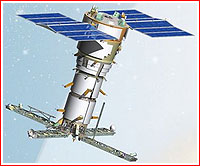
Lotos-S electronic intelligence spacecraft was expected to fly in 2014. Credit: Arsenal
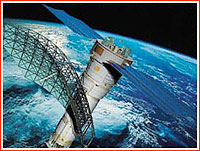
This promotional image approximates the general architecture of the Pion navy electronic intelligence satellite. The actual vehicle carries not one but two radar antennas, as well as deployable panels with receiving sensors similar to those on the Lotos-S satellite (above). Credit: TsNIRTI
Sensor and antenna section of the Liana electronic intelligence satellite. Click to enlarge. Credit: Roskosmos
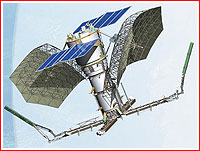
As of 2014, Pion-NKS (14F139) spacecraft for radar and radio surveillance was promised to fly in 2015. Credit: Arsenal
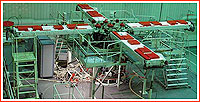
Deployable panels of the Lotos spacecraft carrying ELINT sensors (under red covers). Credit: TsNIRTI
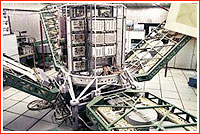
An ELINT satellite payload during development. Credit: TsNIRTI
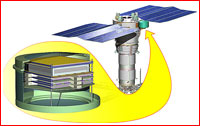
A schematic illustrating the Nuklon experiment onboard the Lotos spacecraft. Credit: KB Arsenal
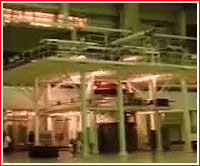
A Lotos-S spacecraft during assembly at MZ Arsenal in St. Petersburg.
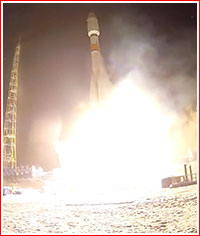
A Soyuz-2-1b rocket lifts off on Dec. 25, 2014, with the second Lotos-S payload. Credit: Russian Ministry of Defense


)